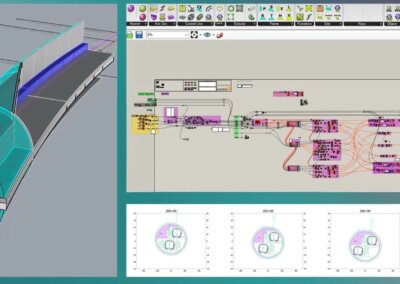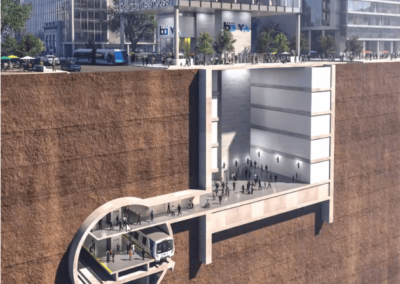About the Project
The San Francisco Bay Area is one of the most populated areas in the US, and more than 350,000 commuters use its 225-km Bay Area Rapid Transit (BART) system every week. Until 2020, however, the network did not reach Santa Clara County—home to Silicon Valley—at the south end of the Bay. The Valley Transportation Authority’s (VTA) transformative BART Silicon Valley Project (BSV) is continuing to expand the BART network through the heart of Santa Clara County, to “ring the Bay” with rapid transit and reduce heavy congestion and emissions on highway corridors.
Currently, the BSV Phase II (BSVII) is extending the BART network 6 km from its terminus at Berryessa through the cities of San Jose and Santa Clara. Along the way, connections will be made to Caltrain commuter rail, VTA light rail and the future California High-Speed Rail. BSVII includes 5 km of single-bore tunnel, three underground stations, one at-grade station, and a new yard maintenance facility. It is expected to be the single largest public infrastructure project ever constructed in Santa Clara County.
The single-bore tunnel is the defining engineering feature of this project, an innovation that will allow construction through downtown San Jose without significant impacts to surface mobility—even at underground stations. In selecting the single-bore configuration, VTA recognized that “the traditional method of building underground rail, through the use of twin-bores and cut and cover stations, is not always appropriate, especially in dense urban areas.” It will be only the second single-bore transit tunnel in the world—and the first for a heavy rail system.
Mott MacDonald, as the lead joint venture partner for the design and engineering of BSVII, provided VTA with tunnel design, geotechnical engineering, track and systems development, ventilation system analysis and design, and station design for the single-bore transit tunnel, among other engineering services.
Approach
A primary design objective for a bored tunnel is to minimize its fixed diameter—a major determinant of its feasibility, cost and construction impacts. To do so, engineers rigorously “spaceproof” the tunnel’s components, accurately modeling the geometry of each to ensure all fit together within the bore. Spaceproofing a single-bore transit tunnel is a particular challenge: the inbound and outbound guideways shift up and down, left and right, in a complex dance with the ventilation system and station platforms.
Such transitions are beyond the present capability of industry-standard modeling software. So, our Vancouver-based digital services team combined with Bay Area-tunnel engineers to invent this capability—and spaceproof the single-bore transit tunnel—using computational design. We coded the engineers’ design logic in a collection of Python and Grasshopper scripts. Given a set of design assumptions—parameters—the scripts would automatically generate accurate, intuitive three-dimensional models of each transition. The engineers varied the parameters to explore their designs, test hypotheses, and challenge assumptions. We refined the scripts to capture the engineers’ advancing understanding, and “rapid prototyping” soon emerged. Thus, the tunnel engineers could demonstrate confidence in a singular design. Our collaborative computational design approach is a foundation for this confidence—and an important contributor to the innovation of the BSVII single-bore transit tunnel.
Results
Our computational design approach helped to move BSV toward its objective of “ringing the Bay” with rapid transit. It demonstrates one possibility for technology as a force multiplier to find creative solutions to difficult, open-ended—and often long-standing—engineering challenges.
Computational design, done well, opens horizons: it expands the possibility of what we can accomplish through engineering. And the leading edge of computational design practice is right here, in British Columbia.
Service(s) Provided
Design leadership
Bored tunnel design
Geotechnical engineering
Track and systems development
Ventilation system analysis and design
Station design
Project Team (Consultants)
PGH Wong Engineering
Go back to projects in
View other projects from
Stay in touch with us
Subscribe to our mailing list!
Organization
Connect






